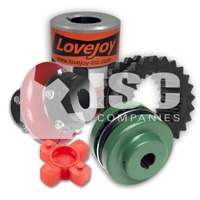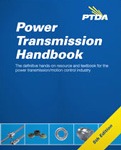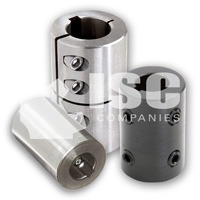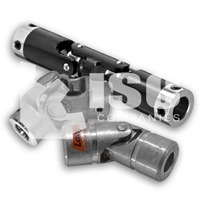 Flexible Shaft Couplings
Flexible Shaft Couplings
ISC Companies and affiliate Adams-ISC are distributors of mechanical power transmission parts including flexible shaft couplings. For more information about the brands we offer and/or pricing, please contact us by phone 763-559-0033, by email [email protected], or by filling out our online contact form.
Flexible couplings connect two shafts, end-to-end and in the same line, causing both to rotate at the same speed. They also flex to compensate for misalignment and movement between shafts. This compensation is crucial because perfect alignment of two shafts is extremely difficult and rarely achieved. There are two types of misalignment: angular and parallel. Most flexible couplings also accommodate axial movement, or end float, of the shafts.
Depending on the type, most flexible couplings can accommodate from 1/4 of a degree to 4 degrees of misalignment. Low speed couplings are aligned to 0.001 in/in (3.5 seconds) and for high speed, they are aligned even tighter at 0.0005 in/in (1.75 minutes). Maximum parallel misalignment can range from a few hundredths of an inch to over an inch.
Other Functions of Flexible Shaft Couplings:
- Dampen vibration and reduce shock loads
- Protect against overload
- Measure output torque of driven equipment
- Insulate the driver from the driven
- Position a rotor of a motor or generator
- Tune a system out of a torsional critical condition
Types of Flexible Shaft Couplings
- Mechanically Flexible: obtain flexibility from a clearance between components that allows rolling or sliding. They require lubrication unless a moving part is made from a self-lubricating material.
- Elastomeric Element: obtain flexibility from shear or compression of a resilient polymer material, like rubber or plastic. The material may be mechanically interlocked, bolted, clamped, or molded to the hubs. They offer better shock and vibration damping than other types but are subject to operating temperature limitations.
- Metallic Element: obtain flexibility from the flexing of thin metallic discs or diaphragms.
- Miscellaneous: obtain flexibility from a combination of mechanisms mentioned above.
Mechanically Flexible
Gear Couplings
The most power-dense type of coupling. Typically, they consist of two hubs with external teeth that engage internal teeth on a two- or one-piece flanged sleeve. They can transmit high torque at high speeds and can accommodate misalignment with axial clearance between gear teeth, called backlash. Some have curved teeth for increased angular misalignment and relieving edge loading between teeth.
Chain Couplings
These have two hubs with sprockets rather than teeth. The sprockets are connected by double-strand roller chain. Most are open and lubricated by brushing grease on the chain. Chain couplings do not transmit as much power as gear couplings but are usually less costly. They are used for low speed, moderate torque applications. There are three types:
- Double roller chain: most common, suitable for moderate speeds and loads.
- Silent: used for heavy-duty drives requiring high torque.
- Plastic: use nylon chain that requires no lubrication. Used where lubrication is undesirable (textile and food industry) and in corrosive environments.
Grid Couplings
Consist of two hubs with multiple slots, through which a steel grid weaves back and forth. Misalignment and float are accommodated by the sliding motion of the grid within lubricated slots. This configuration provides torsional flexibility under different loads, vibration dampening, and the cushioning of shock loads. They are usually composed of metal, require lubrication, and have covers to retain lubricant and prevent contamination. They are used for medium and small equipment applications like pumps and high-capacity bulk conveyors.
Elastomeric Element
Urethane Tire Couplings
The elastomeric element is shear and made of urethane, polyurethane, or polyether material. They are split for easy assembly and offer a high degree of flexibility. When the coupling fails, usually only the elastomeric part is replaced.
Jaw Couplings
Jaw couplings have two hubs with projecting jaws that mate with a one-piece elastomeric spider insert. For higher power applications, individual load cushions can be substituted for the spider. Torsional stiffness and torque capacity vary with the number, width, and shape of the jaws. Use caution, as sometimes they are used to absorb energy and dampen loads, especially when equipment is engine driven.
Sliding Block Couplings (Oldham’s)
These have two hubs with jaw-shaped flanges positioned at right angles to each other to engage opposing surfaces of a sliding center block. This type compensates for all three types of misalignment by the sliding action between the center block and the adjacent driving and driven jaw flanges.
Pin and Bushing Coupling
Relative movement is accommodated by compression of steel-bonded bushings. They are used to absorb energy and dampen loads, especially when equipment is engine driven.
Urethane Dual Flex Diaphragm Couplings
These have two urethane elements that are bolted to a composite tube on either side. It is highly flexible and used on small equipment. The element is easily removed by unbolting at the ridges and dropping out the center section.
Bonded-Rubber Shear Couplings
Have an elastomeric element bonded between two hubs, which provides a constant torsional stiffness. The rubber compounds are hard and nearly incompressible, which limits their shock absorbing effect. Designed for low-frequency isolation.
Corded Tire Couplings
Shear-type couplings with a flexible rubber tire and tension-member cords between two flanges. Torque capacity is greater than the urethane tire type. They are often used to reduce the transmission of shock loads to the surrounding equipment in drives subject to jamming.
Donut Couplings – Unclamped
This shear-type coupling has a rubber element with internal and external gear teeth inside two shaft hubs joined together. Provides low torsional stiffness and low reactionary forces, and also dampens shock and vibration.
Compression Donut Couplings
These couplings have a pre-compressed elastic element. Screws force the donut to a smaller diameter. They provide low torsional and lateral stiffness.
Block Couplings
Block couplings have rubber blocks installed in cavities formed by internal sleeve blades, an external hub blade, and two end plates. This coupling is unique due to its fail-safe feature; if the elastomeric fails, the coupling can run for some time on the metal blades.
Metallic Element
Disc Couplings
Metal disc couplings contain a series of thin, flexible steel discs bolted between coupling flanges. Discs come in different shapes including square, octagonal, scalloped, circular, and are made from linked segments. They flex to permit angular or parallel misalignment and end float while providing torsional rigidity. With no sliding parts, they do not require lubrication.They are often used in pumps, blowers, fans, compressors, and motor generator sets.
Miscellaneous
Metallic Beam
Beam couplings, or helical couplings, are one-piece metal beam cylinders with spiral slots that are cut to form a spring-like flexing portion. Beams are shaped to allow torque transmission in either direction. They are considered miniature and used in small-sized equipment applications where zero backlash and easy installation are important.
Metal Bellows Couplings
Consist of two hubs connected by a flexible bellows section and accommodate 5-10 degrees angular misalignment in light-duty applications, such as motor-to-encoder connections, resolvers, servomotors, robots, instruments, and machine tools. They have high torsional stiffness and negligible backlash.
Tangential Spring Couplings
Consist of one or more square-wire springs that are concentrically wound and connected to hubs at each end of the spring. Available in standard and miniature sizes.
Top Brands We Offer
 Content on this page was created using excerpts from the Power Transmission Handbook (5th Edition), which is written and sold by the Power Transmission Distributor’s Association (PTDA).
Content on this page was created using excerpts from the Power Transmission Handbook (5th Edition), which is written and sold by the Power Transmission Distributor’s Association (PTDA).




















You must be logged in to post a comment.